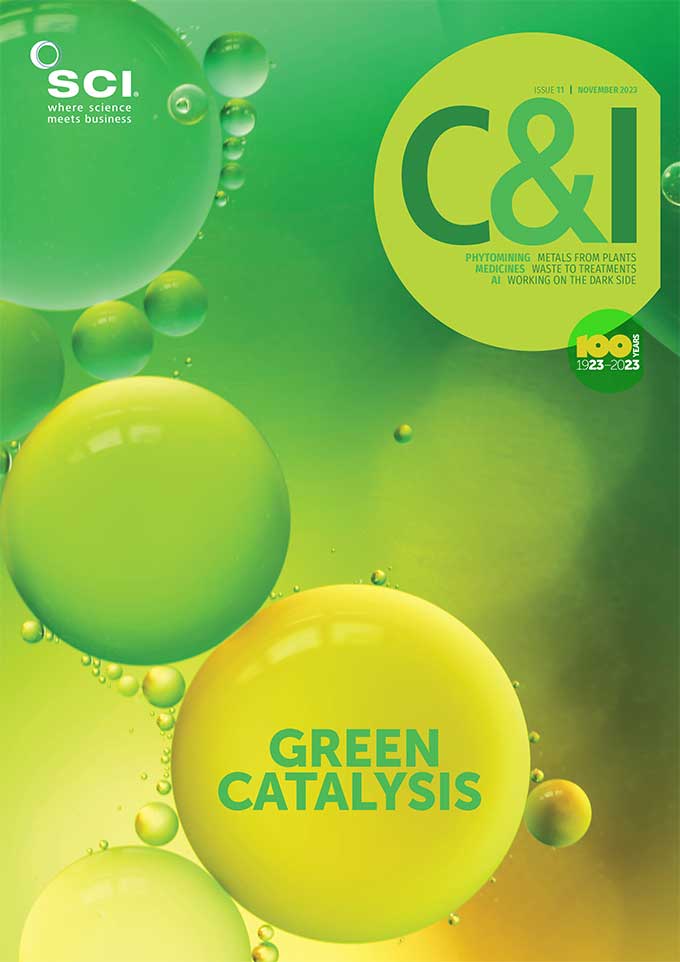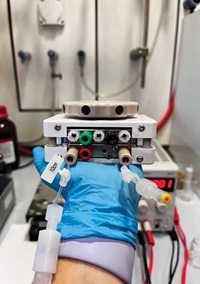BY ANTHONY KING | 8 NOVEMBER 2023
Researchers speed up chemical reactions with the flick of a switch.
A flick of a switch to apply an external electric field can accelerate a chemical reaction, a collaboration between Welsh and Swiss researchers has shown.
The reaction happens inside a microfluidic device, where around 0.5mL of reactant fluid flows between two electrodes placed as close together as possible. This could transform organic synthesis and revolutionise the manufacture of chemicals.
‘The expectation is that this should really speed up and direct every reaction in organic synthesis,’ says chemist Stefan Matile, who led the Swiss side from his University of Geneva lab. ‘If this is true, this really will have an enormous impact.’
The reactants in the experiment weakly interact with carbon nanotubes coated onto the electrodes. Crucially, the device was used to strengthen anion-π catalysis, which is the stabilisation of anionic transition states on aromatic surfaces (Science Advances, doi: 10.1126/sciadv.adj5502).
‘We don’t add or subtract electrons. We only use this device to create an electric field,’ says Thomas Wirth at the University of Cardiff. He had developed the electrochemical device for redox chemistry. In the new experiment, the substrates stick to the carbon nanotubes, due to a π-stacking aromatic linker attached, so they can be exposed to an electric field.
All chemical reactions are the result of roving electrons. ‘Electrons are moving from one place to another during reactions, and if you can accelerate or direct these electrons, then you can completely change the world,’ says Matile.
The field in the Cardiff device is kept weak enough not to transfer electrons, but to influence the reaction. ‘Without the trick of temporary polarisation with external electric fields, anion-π catalysis involves increasing the electron deficiency of an aromatic system to the point where it becomes more and more unstable,’ Matile explains.
An important part of the backstory is that the combination of anion-π catalysis with electric field assistance has proved difficult to demonstrate. Matile first reported in 2017 on how an electric field can lead to catalysis of the addition reaction of malonic acid half thioesters to enolate acceptors bound to metal oxide surfaces (JACS, doi: 10.1021/jacs.7b02421).
‘But [research into] anion-pi catalysis has been essentially impact-free,’ says Matile. ‘I hope that this paper will lift the principle of anion-pi catalysis and electric-field induced catalysis to a completely new and general level.’
Wirth visited Geneva at the invitation of Matile, after the Swiss researcher had read about his device. PhD student Ángeles Gutiérrez López then travelled from the Geneva lab to Cardiff with her previously developed anion-pi catalysis reactants in solution. Meanwhile, Wirth and PhD student Rojan Ali had their machine ready to go.
The device takes the form of a small box in which the reaction medium circulates between two electrodes producing the electric field. Image: Stefan Matile
The results came about rapidly. Demonstration molecules were placed in the reactor to generate a model reaction – pyrene-interfaced epoxide-opening ether cyclisations. It’s a nice ‘textbook’ organic reaction, notes Matile.
‘Within three-to-four weeks we got most of the results now reported in this paper,’ recalls Wirth. Matile suspected the machine had the potential to remove many obstacles he had encountered in trying to combine anion-pi catalysis with electric fields, but was ‘very surprised,’ at how quickly the experiments progressed. ‘Usually, these things take a year or two,’ he says.
Theoretical chemist Sason Shaik at the Hebrew University of Jerusalem, Israel, had predicted in the early 2000s that oriented external electric fields could catalyse and control a variety of non-redox reactions (Nature Chem, doi:10.1038/nchem.2651).
He praises the use of multiwalled carbon nanotubes (MWCNT) to catalyse the opening of the epoxide moieties and transform them to ether products. ‘The use of MWCNT, which are pi-delocalised and hence highly polarisable is ingenious, and it gives rise to a large electric field in a low voltage, which does not involve electron transfer,’ notes Shaik.
He adds that ‘these reactors work without additional electrolytes, which is a real breakthrough with regard to practice, because electrolytes interfere with field-induced catalysis and have caused complications in the past.’
Shaik foresees benefits in the continuous flow system: ‘This method is scaleable and we may expect to see in the foreseeable future the emergence of a procedure that harnesses oriented molecular electric fields to produce quantitative product yields.’
The next step, according to both labs, is to synthesise useful compounds. ‘We will be able to make drug molecules or material precursor molecules using this new principle of electric-field-inducing reactions,’ says Wirth. ‘Switching off or switching on reactions.’
The reactions should also generate fewer byproducts. ‘This is a very clean process, which does not produce waste, so this is a major benefit of this methodology,’ says Wirth. The Welsh and Swiss labs will pursue the research topic separately, hoping to push forward rapidly with new organic synthesis.






